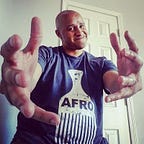What Do Scrum Masters Do All Day?
My Lightning Talk from Agile 2019
Earlier this year, I submitted two 5-minute talks for consideration in the Lightning Talks track at Agile 2019: “10 Reasons Why Mr. Miyagi is the Ultimate Scrum Master,” and “What Do Scrum Masters Do All Day?” The way it worked was when submissions closed, Agile Alliance members were s’pose to vote on the ones they liked the most. Those with the most votes would then be considered for inclusion.
I promo’d the hell out of my Mr. Miyagi submission, which ended up being 6th overall in popularity. I hoped that it’d get selected. Sometime later, I ended up receiving two emails from the Agile Alliance. One stated, “Congrats, your talk has been selected,” while the other stated, “Sorry, you didn’t get enough votes.” To my surprise, the Scrum Master talk made the cut.
The original intent for this presentation was to be a full length talk. I’ve submitted it to a few other upcoming conferences too. I had my work cut out for me to shave it down to 5-minutes. While I’ll be giving the presentation in its entirety at Agile Midwest 2019 this September, I wanted to share a few slides, and the content from my Agile 2019 lightning talk. With well over 100 people in the room, I stepped up to the mic, and let it rip.
“I wanna share a story about my experience with a question you may have heard before: “What do Scrum Masters do all day?” In answering this question, I’m not going to preach that all Scrum Masters should be doing x, y, and z. This is simply my story. But there’s a tendency to think that all we do is run a few meetings, play with Post-its, and make developers talk about their feelings. I wanted to dig deeper into this, so I asked my teams, “What do Scrum Masters do?” Here’s some of their replies.”
“It was clear to me that Scrum Masters are seen as emcees (MCs), or masters of ceremonies. Even we call ’em ceremonies (I’ve struggled to find the origins of this widely-disseminated term), and it’s not doing us any favors. The connotation is that we’re the ones responsible for scheduling, and running meetings rather than being advocates for meaningful change. But if we’re not scheduling meetings, one might ask, “What the hell are Scrum Masters s’pose to be doing?”
“Scientists run experiments to test out a theory. So I figured, why not do the same? Retrospectives are the most obvious candidates for experimentation (what Scrum Master doesn’t enjoy facilitating retros?) but what about Sprint Planning, or Backlog Refinement? I’ve got three words for you…”
“I also reminded my teams about the importance of technical excellence (things like Test-Driven Development, CI/CD, DevSecOps, etc…); a callback to the Manifesto. Agile 2019 has an entire track on coaching technical skills.”
“And let’s not forget, there are three distinct areas Scrum Masters are supposed to provide support: the product owner, the development team, and the organization. The Tuckman Model should be pretty familiar. When teams reach the norming, or performing phases, they don’t necessarily need to rely on their Scrum Master so heavily. They know how the game works, and for the most part should be able to run on their own.”
“It’s here when we can shift our focus elsewhere: the organization. By now, people know what Agile is, but knowledge does not equal understanding. Building a shared understanding throughout the organization became a priority. In doing so, I figured why not experiment in areas outside of software development within the organization?”
“What if lawyers applied agile practices? I gave a talk to the legal, and compliance departments, and surprisingly, they’d already adopted some of the practices without even knowing it. They were even doing better with some where developers struggle.”
“Back in the 1980s, there was a movie called The Beast Master, based on a 1959 novel of the same name, about a dude who could talk to animals. Obviously, he was a master of beasts. It makes sense that Scrum Masters should be masters of Scrum.”
“And like Mr. Miyagi said, “There’s no such thing as a bad student. Only a bad teacher.” It’s a big world out there. My mission became to learn, contribute, and collaborate with the overall Agile community. I took it upon myself to do so with folks from all over. I took it upon myself to read everything I could get my hands on, and take additional training. I started writing for Serious Scrum, ultimately becoming one of the editors, and achieved my goal of speaking at Agile 2019.”
“So much of what Scrum Masters do revolves around people, and psychology. Yet there’s such a heavy focus on velocity, story points, and “the work.” When we shift focus to build around people, awesome work inevitably follows.”
“I tend to coach people that the point isn’t to BE agile, but to use Agile as a tool to accomplish meaningful goals. At the end of the day, customers don’t care whether you’re down with Scrum, Kanban, SAFe, or whatever. They only want what you’re building.”
“Scrum Masters have the potential to be superheroes, and treating them like masters of ceremonies can limit an organization’s true potential for change. So the next time you hear the question, “What do Scrum Masters Do All Day?,” what are you gonna say?”
If you wanna peep the slide deck for my Agile 2019 Lightning Talk, “What Do Scrum Masters Do All Day?” in its entirety, you can find it on SlideShare.
